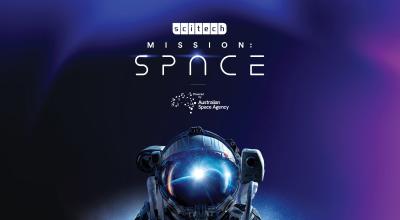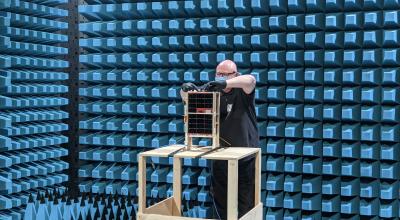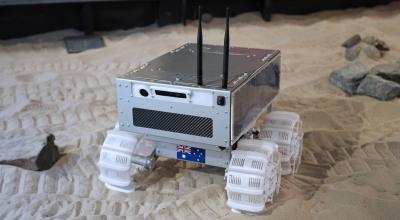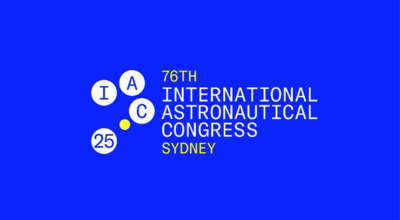The Australian Space Agency and Viasat Australia have signed a Statement of Strategic Intent and Cooperation.
Read the full statement
The Australian Space Agency, an Australian Government agency within the Department of Industry, Innovation and Science, hereinafter referred to as “the Agency” and represented by Mr Enrico Palermo, Head, Australian Space Agency.
Viasat Australia, hereinafter referred to as “Viasat” and in this case, represented by Peter Girvan, Asia-Pacific Vice President.
Recalling that the Australian Civil Space Strategy 2019-2028 is a framework for the development and growth of the Australian space industry over ten years, underpinned by four strategic pillars: International; National; Responsible; and Inspire. Under these pillars the strategy endeavours to help realise opportunities and address challenges by opening doors internationally; increasing national space capability; promoting responsible regulation, risk and space culture; and building the future workforce. The Strategy sets a path for the Agency to triple the size of Australia’s space sector to $12 billion and create another 20,000 jobs by 2030;
Recalling that the Agency's purpose is to transform and grow a globally respected Australian space industry that lifts the broader economy, inspires and improves the lives of Australians – underpinned by strong international and national engagement;
Recalling that the Agency has seven National Civil Space Priority Areas including communications technologies and services; position, navigation and timing infrastructure; space situational awareness and debris monitoring; leapfrog research and development; Earth observation services; robotics and automation on Earth and in space; and access to space;
Recalling that the Agency’s responsibilities include: whole-of-government coordination of Australia's civil space sector matters, providing primary civil space policy and strategic advice to the Australian Government, supporting the growth of our national space industry and the use of space across the broader economy, leading international civil space engagement, administering space activities legislation and delivering on our international obligations, and inspiring both the Australian community and the next generation of space entrepreneurs;
Recalling that the Agency’s values include being responsible, having shared ambition, trust and integrity, entrepreneurial spirit, inclusivity and passion. Its responsible value is linked closely to the Agency’s regulatory responsibilities for Australian space activities, which provides a regulatory framework that enables entrepreneurship while ensuring safety, managing risk, considering Australia’s interests and meeting our international obligations;
Recalling that Viasat is a global communications company that believes everyone and everything in the world can be connected. For more than 30 years, Viasat has helped shape how consumers, businesses, governments, and militaries around the world communicate. Viasat is developing the ultimate global communications network to power high-quality, secure, affordable, fast connections to impact people's lives anywhere they are—on the ground, in the air or at sea. Viasat’s business is to solve high-value, hard problems that create a real impact in the world and deliver the experiences that people want, need, and expect.
Recalling that Viasat’s Australian operations are part of Viasat Inc., a global communications company with revenues over USD$2B and more than 5,500 employees globally, bringing broadband connectivity and advanced communications to consumers as well as commercial and defence organizations.
Recalling that Viasat Australia has been operating since 1990 and currently employs 45 staff across offices in Melbourne, Sydney, and Canberra. Viasat is engaged in the engineering, development, integration and sustainment of advanced technology and communications systems, products and services for commercial and defence organisations in the Asia Pacific region. Viasat is committed to growing its Australian workforce by more than doubling its current workforce in the next two-plus years. The growth predominantly in the highly technical satellite Engineering areas such as radio frequency (RF), fibre, site, network and systems engineering
Recalling that Viasat has a strategic priority to invest in partnerships with Australia’s research and industry communities to support global space initiatives that will spearhead transformational broadband services and communications in the hardest-to-reach locations, providing opportunities for technology transfer, innovation, local skilled jobs and sustainable business growth;
Acknowledging that the Agency and Viasat have shared values and the shared objectives of enhancing the capability, capacity and competitiveness of Australia’s space industry which would impact all National Civil Priority Areas; of increasing domestic and international participation in the sector that will support smart growth and highly qualified jobs in Australia; and improving day-to-day lives through innovative products and services;
Acknowledging that Viasat currently provides a range of products and services to the Australian Defence Force (ADF) including cybersecurity, black core/trusted internet, network encryption, information assurance capabilities, next-generation satellite ground infrastructure, military satellite communications, Link 16 and UHF (ultra-high frequency) radio equipment and deployment and sustainment services;
Acknowledging that Viasat firmly stands behind the safe use of space, and extending space-based communications across commercial, government and academia;
Acknowledging that Viasat has a growing footprint of satellite facilities and highly technical satellite Engineering staff in Australia providing a range of civilian products and services to the telecommunications domain including next-generation satellite ground infrastructure, satellite communications terminals and deployment and sustainment services; and
Through this Statement, Viasat acknowledges the following current projects, areas of strategic interest and growth, and potential new areas of collaboration which contribute to the Australian Civil Space Strategy, the Agency’s National Civil Space Priority Areas, and are of interest to the nation.
International
Growth through IP exportation:
- Viasat is establishing Australia as its Satellite Engineering “hub” for regional Asia Pacific operations by more than doubling its current workforce in the next two-plus years. Initially this will be for the ViaSat-3 generation satellites but will continue for subsequent generations of satellites already under development. Each satellite has an expected life of 15 years. It has been publicly stated that the introduction of the ViaSat-3 satellite constellation will help the satellite communications industry rapidly evolve as the space platform is expected to deliver abundant amounts of capacity to serve millions of people and devices—anywhere: on the ground, in the air and at sea. Australia is well positioned to contribute, capitalise and prosper from this satellite evolution, providing broadband communications services and ancillary IP technology exportation across the region.
National
Earth Observation Services
- Building critical space system infrastructures: Alice Springs Real Time Earth (RTE) - Viasat worked with local Australian partners to construct a Real-Time Earth (RTE) ground station in Alice Springs. This facility enables the delivery of valuable earth observation and remote sensing data in a timely, affordable way and entered service in July 2020. Viasat partnered with the Centre for Appropriate Technology Ltd and Indigenous Business Australia on this multi-million dollar investment which enables central Australia to be a key player in the burgeoning global satellite industry, and indigenous Australians to be leading participants in the space sector. The investment is strongly aligned with the priorities for the Australian Space Agency and seeks to develop world-leading core satellite infrastructure in Australia. Earth Observation brings new, wide-scale opportunities to the region such as new jobs , advancing how remote sensing data is delivered around the world and exploration for how other business sectors can further develop and utilise the RTE technology to benefit science and research organisations across Australia. RTE data actively advances scientific research in areas such as oceanographic, farming, and bushfires to name just a few.
Communications Technologies and Services
- Satellite systems for civilian and defence applications: ViaSat-3 satellite ground infrastructure - Viasat is constructing an ultra-high capacity ViaSat-3 class satellite aimed at the Asia Pacific region as part of its global ViaSat-3 constellation. When complete, the ViaSat-3 constellation will have extremely flexible, cost-effective on-orbit capacity that will provide opportunities to develop both civilian and government business in Australia. This more abundant, cost effective, bandwidth to rural homes and businesses (farms, mines, schools, etc), or to passengers flying internationally, provides substantial benefit. Further, the ViaSat-3 satellite ground infrastructure is currently being designed for deployment solely in Australia, which would ultimately power the region with high-speed satellite broadband. The scope of the programme includes:
- Construction and operation of hundreds of Satellite Access Nodes (SANs), or gateways, connected to reliable, high speed, access fibre. The majority of these SANs will be located in rural and regional areas.
- Construction and operation of a resilient, very high-speed, backbone fibre network including Core Nodes installed in Data Centres.
- Construction and operation of two satellite Telemetry, Tracking and Control (TT&C) sites equipped with 9m dishes.
The construction investment will be made prior to, and immediately after the satellite launch, which is planned for 2023. The network will operate for the 15-year expected lifespan of the satellite.
This programme signifies an investment of hundreds of millions of dollars, over an extended period, into the Australia Space industry and significant portions of the investment will be made in rural and regional Australia. Reliable high-speed satellite services to be offered in Australia, and across Asia, include:
- Residential Services
- Enterprise Services
- Mobility Services (Commercial Air, Business Aviation, Maritime, Land Mobile, Nomadic Terminals)
- Community WiFi
- Government Services
Benefitting all Australians and the potential to create dozens of highly technical Engineering/Programme jobs as well as hundreds of construction/maintenance jobs over the time horizon of the network.
- Next-generation equipment propelling communications forward: nbn Skymuster satellite ground infrastructure - Viasat built and supports (via a local team) the nbn™ Skymuster ground infrastructure, which includes ten Gateways and two Data Processing Centres. Viasat also supplies the terminal/customer premise equipment and antennas for at-home use. The Skymuster service provides nbn internet service to over 100,000 remote and rural Australians. Viasat works continually with nbn on transferring world leading technology and techniques into this network based on the ongoing development Viasat undertakes on its own extensive, global, satellite fleet and ground infrastructure.
- Connecting Australia, coast-to-coast: USO Voice Satcom Terminals - Viasat supplies home satellite terminals that provide voice services to remote and rural Australians helping meet the Australian Universal Service Obligation.
- Empowering the aviation industry with proven satellite connectivity: Qantas Inflight Connectivity - Since 2017, Viasat has supplied the in-flight connectivity service on the Qantas domestic fleet of B737 and A330 aircraft. The Viasat in-flight Wi-Fi service connects Qantas passengers, crew and pilots to fast, high-quality internet, including streaming media services, gate-to-gate. The airline is also looking at innovative new ways to leverage in-flight connectivity to increase its business utility. One such example is its Electronic Flight Bag application, which is used for tracking and visualising weather, turbulence modelling and to improve pilots' overall situational awareness when in flight.
- Satellite communications to support home station and deployed military Defence Joint Project 2008 Phase 5B2 - Viasat is one of the joint contractors for Satellite Ground Station – East which is the construction and sustainment support of a satellite gateway to anchor Wideband Global Satellites (WGS) visible from the east coast of Australia.
- Smart satellite system network management design: Defence Joint Project 2008 Phase 5A - Viasat is the prime contractor for the ground infrastructure which provides UHF satellite communications coverage over the Indian and Pacific Ocean region. This region being vital to the future sovereign security of Australia. Viasat designed the system to include the Integrated Waveform for channel control and network terminals, which aims to enable an increase in channel efficiency and available satellite communications bandwidth.
- Effectively serving the ADF: Maintenance, Test and Integration Facilities (MTIF) - Viasat established two MTIFs in Canberra and Newcastle, Australia. The facilities are strategically located to align with the ADF. The first MTIF, currently employing four staff, was established within the Canberra airport precinct and was developed to provide technical support, product demonstrations and repair capabilities for military satellite communications products. The second MTIF, currently employing two staff, and strategically located near the Williamtown airbase in Newcastle, supports training, technical support and repair capabilities for Viasat’s expansive line of Link 16 products. To date nearly 200 ADF staff have been trained with around half at the MTIF itself. It is forecast to train around 100 additional ADF staff per year split between ADF sites and the MTIF. In addition to providing training and technical support, these two facilities are equipped to provide Intermediate Level depot support for significantly faster repair capabilities.
Building the Future Workforce
- Local investment and workforce expansion to meet space priorities: Viasat understands the importance of growing the capabilities and capacity of the Australian workforce to meet future demands of the space economy. Viasat is committed to growing its Australian workforce by more than doubling its current workforce of 45 in the next two-plus years. The growth is predominantly in the highly technical satellite engineering areas such as RF, Fibre, Site, Network and Systems Engineering. This growth will support Viasat’s intentions to be the first global service provider—where Australia will take a leading role in Viasat’s ability to bring high-speed broadband communications to the greater Asia-Pacific region. It will also help bring additional technology capabilities and sovereign resources to Australia and its collaborative partners.
- Driving inherent value from Intellectual Property (IP) exchange: Viasat understands that ‘data as an asset’ and is therefore open to exploring opportunities for knowledge exchange. Potential contribution of Viasat’s various products and software tools may help progress the development and delivery of civilian applications and services (e.g. emergency services, disaster relief, law enforcement and maritime, to name a few).
Inspire
- Expanding local educational opportunities to drive workforce recruitment: Viasat recognises the importance of growing the capabilities and capacity of the Australian workforce to meet future space, broadband and defence demands. Viasat has an extensive intern and graduate programme in the US. Viasat intends to extend that programme to Australia in 2021 with an expectation to employ new graduates in early 2022. The new graduates will be employed as part of the doubling of the Australian workforce.
This Statement constitutes the expression of both parties’ intention to continue discussions. This Statement does not create legal obligations between the parties and does not establish the obligation to enter into a certain agreement.









